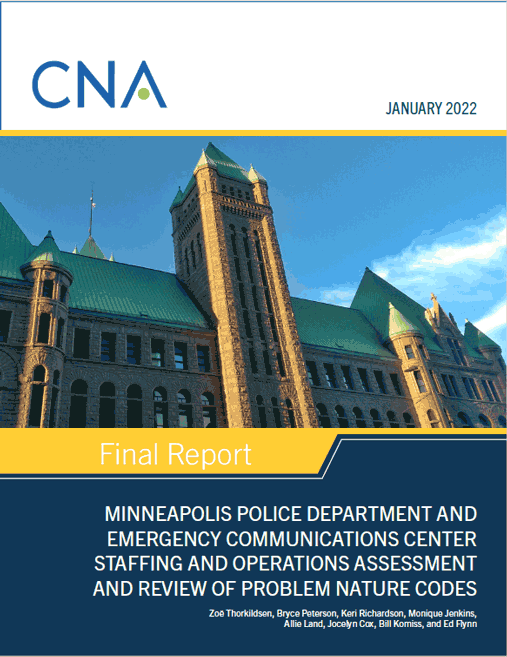Goals and objectives
This analysis will achieve the following:
- Recommend staffing resources that can effectively and efficiently meet the demand for service.
- Review internal business processes and identify gaps and areas for improvement.
- Inform needs for resource allocations that are aligned with City needs and demand for public safety services.
- Position the MPD for future success by providing the tools to further adapt staffing and processes to future changes in demand for service.
Areas of focus and approach
Our report is organized into four major focus areas: staffing analysis, operations analysis, and problem nature code analysis, and business processes analysis.
Staffing analysis
Using a workload-based approach, CNA produced estimates of the staffing required to support the MPD’s current patrol workloads and evaluated the use of different shift lengths. In addition, we analyzed breakouts by specific call response types to estimate the effects of changing response policies (e.g., implementing alternate response models for mental health calls and property crimes) on staffing needs.
Operations analysis
Using data collected from personnel interviews as well as review of the literature and peer agency practices, CNA assessed MPD operations and policies, including the use of one- versus two-person patrols, relative levels of civilianization, alternative response models (which also have implications for the staffing analysis), and information technology enterprise system use.
Problem nature code analysis
Using calls-for-service data, including 9-1-1 call data, CNA reviewed the use of problem nature codes in the MECC using an exploratory descriptive analytical approach.
Business process analysis
Using information from personnel interviews as well as review of operational documents, CNA assessed business processes in the MECC, Patrol Bureau, specialty units, and the investigative functions at MPD. We used a process mapping and pain points identification approach to map how business processes currently function and areas to improve the effectiveness and efficiency of these processes.
Across each of these focus areas, CNA relied on both quantitative and qualitative data from the MPD and MECC. These data sources included calls-for-service and 9-1-1 call data from 2016 through 2020, staffing data, documentation of MPD and MECC policies and procedures (including training materials), and information gathered through interviews with MPD and MECC personnel. Data sources and analytical techniques are described in more detail in each of the sections below.
For most of the quantitative analyses in the report, we used data from 2016 through 2020. As a result of the COVID-19 pandemic as well as changes in policing practice and policy after the death of George Floyd, policing response in 2020 differed from preceding years in substantive ways. Specifically, in Minneapolis as well as other cities across the country, nearly all measures of police activity were lower in 2020. However, we included 2020 in our analyses for the following reasons:
- Despite being unusual, 2020 represents the most recent year of data available at the time we performed analysis, and timely data are almost always preferable to older data.
- For the majority of our analyses, we relied on a five-year period of data, and thus the inclusion of 2020 did not drive the results.
- Trends seen in 2020 continued into 2021 for agencies nationwide; it is unclear whether or when police activity levels will return to pre-2020 levels, so to discount 2020 data as irrelevant would be improper.
Overview of the report
This report contains six sections, including this introductory section. Following this section are sections presenting analysis, findings, and recommendations related to the staffing analysis, operations analysis, problem nature code analysis, and business processes analysis. The report closes with a brief conclusion section.
Download reportDistribution: Distribution unlimited.
Details
- Pages: 84
- Document Number: IRM-2021-U-031461
- Publication Date: 1/3/2022
